Presbyphonia (Aging Voice)
Home | Voice, Throat & Swallowing | Presbyphonia / Aging Voice
What is Presbyphonia (Aging Voice)? What Is The Definition of Presbyphonia?
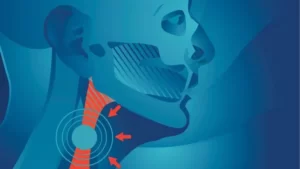 Presbyphonia, also known as presbylarynx or aging voice, refers to the age-related changes in the upper airway and digestive tract that result in voice changes. As part of the normal aging process, the muscles that sustain and support our vocal cords, as well as the structure of the voice box, may alter and change. These changes can affect the way we use our voice and the way it sounds, and usually occur after age 60.
Presbyphonia, also known as presbylarynx or aging voice, refers to the age-related changes in the upper airway and digestive tract that result in voice changes. As part of the normal aging process, the muscles that sustain and support our vocal cords, as well as the structure of the voice box, may alter and change. These changes can affect the way we use our voice and the way it sounds, and usually occur after age 60.
Presbyphonia is not a pathological issue. However, it may have wide-ranging effects on a person’s ability to communicate. This may affect social interactions, work interactions and may also have psychological effects on an individual. If these effects reach a point where a person’s ability to communicate effectively is impaired, quality-of-life issues may result.
How Is Voice Produced?
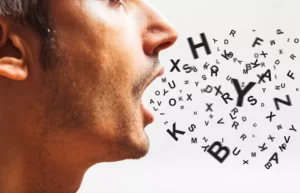 Three components work together to produce the voice.
Three components work together to produce the voice.
The first is the lung, which – in conjunction with the diaphragm and muscles of the rib, back, and abdomen – presents a stream of air to the voice box.
The second component is the voice box itself. As air passes through the voice box, the vocal cords vibrate, creating a variety of sounds that pass upward through the throat.
Finally, the sound is sent up the supraglottic vocal tract, resonating in the areas which include the throat, mouth, and nose. These air chambers shape the sound into words or song and makes our particular voice unique to us.
How Does Aging Affect Our Voice?
The function or structure of the three components listed below will be affected by age.
Lung
The lung’s contribution to voice production changes because there is a decreased force and rate of contraction of the respiratory muscles, along with a stiffening of the chest and loss of elasticity of lung tissue. Such changes decrease the ability to generate sufficient air flowing upwards from the lungs through the voice box.
Larynx (voice box)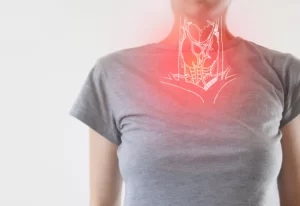
The larynx also changes as the cartilage in the larynx calcifies with age. There are joints in the larynx called the arytenoid joints. With aging, these joints develop irregularities; and the laryngeal muscles also undergo atrophy; with the muscle bulk being replaced with fat and connective tissue. All these changes limit the amount of tension that our larynx can place on the vocal cords, making the voice weaker and breathier.
These age-related changes influence the pitch of the voice. Usually, this results in the voice becoming breathier, weaker and increasingly high-pitched. It may be difficult to hear such a voice in environments with significant background noise, such as restaurants or in large social gatherings. In addition, many such patients report significant vocal tiredness and fatigue.
On visual examination of the larynx in older adults, one typically sees bowing or atrophy of the vocal cords with an elliptical gap between them.
Supraglottic Vocal Tract
With age, the facial muscles atrophy and lose elasticity, as do the tissues in the mouth. The dental structure also changes with age. In addition, the palatal and pharyngeal muscles also degenerate with age and become are less toned. Finally, decreased salivary flow and secretion leads to a dry mouth, oral discomfort, and dysphagia / odynophagia.
What Are Some Symptoms Of Presbyphonia?
Patients with presbyphonia may experience:
- Occasional or frequent breaks in voice
- A breathy voice
- Tension in the larynx
- Sudden interruptions in normal speech flow
- Reduced highs and lows in vocal range
- Reduced volume
- Hoarseness
- Vocal fatigue
The severity of symptoms varies from person to person, and even vary from different times in the day.
How Is Presbyphonia Diagnosed?
The diagnosis of presbyphonia is generally one of exclusion. Other conditions that may present with similar voice complaints must first be ruled out. Some other conditions include vocal cord nodules / cysts, vocal cord paralysis from a variety of conditions including cancer, and Parkinson’s disease. Patients with depression, or frail patients, may also demonstrate a softer/weaker voice. This may be helped by treatment.
The key diagnostic tests are:
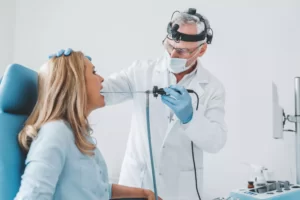 Nasoendoscopy during respiration, phonation, and at rest
Nasoendoscopy during respiration, phonation, and at rest- Videostroboscopy (examining the vibratory pattern of the vocal folds during phonation with a strobe light). Abnormalities of this vibration suggest possible underlying conditions such as polyps or cysts.
Individuals with presbyphonia will have normal mobility of the vocal cords and normal vibration. However, their vocal cords may have atrophied and have decreased musculature that interferes with the ability to bring the vocal cords tightly together. This vocal cord insufficiency contributes to the weak, breathy voice and vocal fatigue.
What Are Some Treatment Options For Presbyphonia?
A variety of treatments are available depending on the voice requirements of the patient, and how it potentially affects quality-of-life.Most patients are encouraged to try voice therapy in the form of presbyphonia exercises before moving on to invasive procedures.
Voice Therapy for Presbyphonia
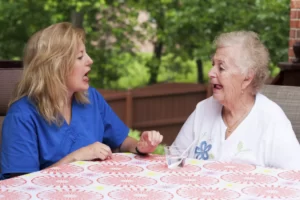 Voice therapy for presbyphonia is administered by a speech and language pathologist and involves two components. The first key component is teaching the patient about voice production and how to keep the voice in good health. The second is presbyphonia exercises, in which patients are taught aging voice exercises to strengthen the voice. Voice therapy and voice exercises for presbyphonia are the first-line treatment and most patients participate in 4-8 therapy sessions.
Voice therapy for presbyphonia is administered by a speech and language pathologist and involves two components. The first key component is teaching the patient about voice production and how to keep the voice in good health. The second is presbyphonia exercises, in which patients are taught aging voice exercises to strengthen the voice. Voice therapy and voice exercises for presbyphonia are the first-line treatment and most patients participate in 4-8 therapy sessions.
Invasive Procedures
Some patients may require additional treatment even after voice therapy. Fortunately, there are both minimally invasive and open procedures. Less than 20% of patients diagnosed with presbyphonia undergo such procedures.
Injection laryngoplasty, also known as medialization of the vocal fold, involves injection of a material such as calcium hydroxylapatite, hyaluronic acid, collagen, or others, next to the vocal folds to close the gap between the vocal folds, thus reducing breathiness and improving voice. This may be performed under general anesthesia or as a convenient procedure in the clinic.
Another more definitive approach, bilateral medialization thyroplasty, is an open surgical procedure performed under local anesthesia with mild sedation. Access to the larynx is obtained through the neck, and a small portion of the laryngeal cartilage overlying the vocal cords is removed. Subsequently, a specific material is implanted in the neck, deep to the laryngeal cartilage and next to the vocal fold, to push it medially.
If voice therapy has not provided results which the patient deem sufficient, injection laryngoplasty can be recommended as a trial procedure. If the results are satisfactory to the patient, they may opt for repeat injections or choose to proceed with permanent correction by undergoing bilateral medialization thyroplasty.,

